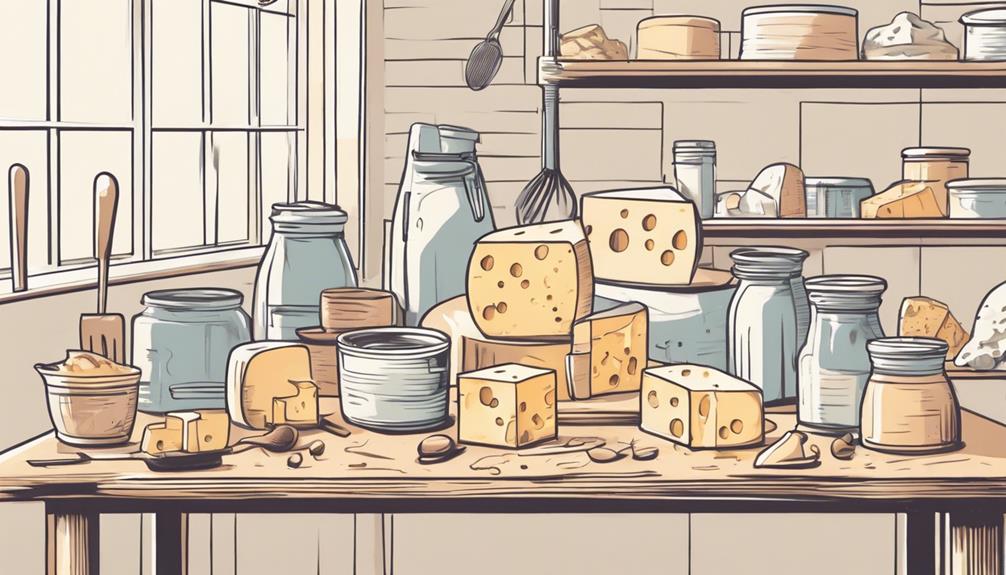How To Become More Self-Sufficient Without Starting a Full-Blown Farm…
Want to start preserving your harvest, making your own soap, or building a backyard root cellar — but not sure where to begin? “Homesteading Advice” gives you instant lifetime access to 35+ practical homesteading books on food preservation, veggie gardening, DIY natural cleaning products (save over $250 per year with this skill alone), brewing, off-grid energy, and a whole lot more…
Click Here To Check It Out Now!
“I’ve just started making cheese at a small workshop in Portland, Oregon. As someone new to the field, I’m really concerned about preventing cross-contamination to ensure the quality and safety of my cheese. What are the best practices to prevent this?” Thanks, Karen, Portland, USA.
How Do You Prevent Cross-Contamination in Cheese Making?
Hey Karen! That’s a fantastic question and a concern many of us share. Cross-contamination can really mess up the quality and safety of your cheese, but don’t worry, there are plenty of things you can do to prevent it. Let’s go through some effective strategies to keep your cheese pure and delicious!
Understanding Cross-Contamination
Cross-contamination occurs when harmful bacteria or allergens transfer from one surface or food to another. This can happen through direct contact or indirectly through equipment, hands, or even air particles. It’s particularly important to avoid during cheese making because even a small lapse in hygiene can spoil the entire batch.
Personal Hygiene
Your first line of defense against cross-contamination is personal hygiene. Here are some key practices:
- Hand Washing: Always wash your hands thoroughly with warm water and soap before starting any cheese-making process. Don’t forget to wash again before moving from one task to another.
- Proper Attire: Wear clean clothes, and consider using a hairnet or hat, apron, and gloves. This keeps personal contaminants like hair, skin cells, and small particles from your clothes out of your cheese.
- Health Precautions: If you’re sick, it’s best to avoid cheese making. You wouldn’t want to contaminate your cheese with any bacteria or viruses you may be carrying.
Sanitizing Equipment and Workspaces
Keeping your tools and workspace clean is crucial. Contaminated equipment can easily spoil your product.
- Regular Cleaning: Before and after each cheese-making session, clean all equipment and surfaces with hot soapy water. Rinse well and allow to air dry.
- Use Sanitizers: Use food-safe sanitizers on all equipment and surfaces. Make sure to follow the manufacturer’s instructions for proper use and dilution.
- High-Temperature Sanitization: Another effective method is using steam or boiling water to sanitize your tools and surfaces.
- Designated Areas: Have separate areas for different tasks—one for milk processing, another for curd cutting, and so on. This separation helps minimize the risk of cross-contamination.
Milk Handling
Milk is the foundation of cheese, so handling it properly is incredibly important. Here’s what you need to do:
- Source Quality Milk: Always use high-quality and pasteurized milk from reputable suppliers. If you’re using raw milk, ensure it comes from a reliable source and handle it with extreme care.
- Immediate Cooling: After milking, cool the milk immediately to below 40°F to prevent bacterial growth. Only bring it to room temperature when you’re ready to start cheese making.
- Sealed Containers: Store milk in clean, sealed containers to prevent exposure to contaminants from the environment.
Avoid Dairy Allergen Contamination
While cross-contamination usually focuses on bacterial threats, you should also be mindful of allergies:
If you’re using different types of milk (cow, goat, sheep), consider making each type of cheese on different days and sanitize thoroughly in between. This ensures allergens don’t transfer from one milk type to another.
Preventing Cross-Contamination During Cheese Aging
The aging process is a crucial period for cheese. Here’s how to maintain cleanliness:
- Clean Aging Rooms: Keep aging rooms clean and at the right temperature and humidity levels. Regularly monitor conditions to prevent mold or bacterial growth.
- Dedicated Aging Spaces: Use different rooms or sections for aging different types of cheeses to avoid cross-contamination through airborne particles or molds.
- Regular Inspection: Inspect your cheeses regularly for any signs of unwanted mold or spoilage. Remove any contaminated cheese immediately to prevent it from affecting the rest.
Education and Training
Mistakes often happen due to a lack of knowledge. Here’s how to stay informed:
- Continuous Learning: Attend cheese-making workshops and seminars. There’s always something new to learn about hygiene and best practices.
- Read and Research: Keep up with the latest research and articles on cheese making and food safety.
- Train Your Team: Ensure everyone involved in the cheese-making process is well-trained in hygiene and sanitation protocols.
Handy Tips and Best Practices
Beyond the fundamentals, here are a few extra tips to keep in mind:
- Use Stainless Steel: Opt for stainless steel equipment where possible. It’s easier to clean and sanitize than plastic or wooden tools.
- Watch the Water: Ensure that the water used in the cheese-making process is clean and boiled if necessary. Contaminated water can introduce pathogens to your cheese.
- Label Everything: Clearly label containers, tools, and storage spaces. This prevents mix-ups and ensures you’re always using equipment for the right purpose.
- Avoid Distracting Activities: When you’re making cheese, focus solely on that. Multitasking can lead to mistakes and contamination.
Final Thoughts…
Hey Karen, thanks for your great question! Preventing cross-contamination in cheese making might seem challenging, but with consistent practice and attention to detail, it becomes second nature. Remember, it’s all about maintaining cleanliness, being mindful of potential contamination sources, and staying educated. Your beautiful, safe, and delicious cheese will be the reward!
Happy cheese making!

